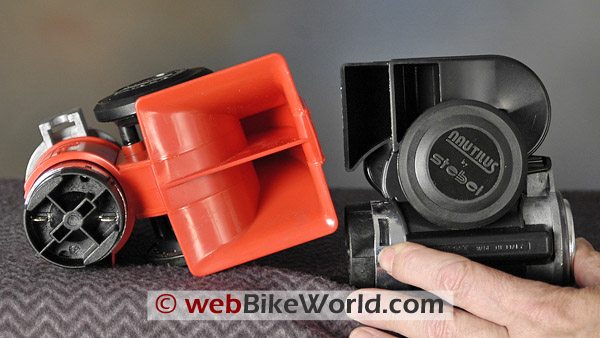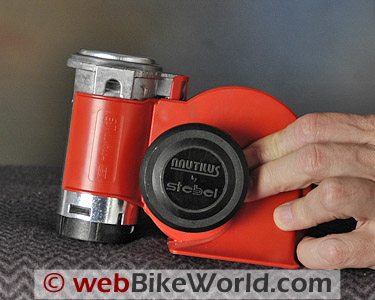Stebel Nautilus Max and Compact Horn
Seemed very loud while it lasted, all 3 seconds of it. The horn failed after about 4 beeps.
Our Stebel Nautilus Compact was inoperative right out of the box, so Stebel has some work to do on the quality of these horns. Not recommended.
I’m not sure if we’ve ever given a product a “Not Recommended” rating, but what else can we do? The Stebel Nautilus “Max” shown here, which is supposedly rated at 139 dB, failed after only a few seconds of use, four beeps to be exact.
And the Stebel Nautilus Compact, also covered in this comparison, was dead on arrival — it did not work even for an instant, and it was brand new, right out of the box.
We didn’t even get a chance to run the big, red Stebel Nautilus Max through the sound level meter, so it’s uncertain how it would score against the other horns in this comparison article. It did seem loud while it lasted though, but it has an “air horn” quality that not everyone likes
The Stebel Nautilus
The Stebel Nautilus horns of either variety are very large and have a very irregular shape. This and the very poor mounting bracket (the half-moon shaped cutout in the top of the cylinder in the photo above) makes it very difficult to fit on a motorcycle. Owners would probably have to fashion a custom-made bracket of some sort.
But it would be nearly impossible to mount anyway on the slim GT1000 and who knows how it would sound when the horn was pointed downwards, to keep out water, as the instructions indicate.
But the loudest motorcycle horn in the world is useless if it can’t be trusted, and based on our experience with the Stebel Nautilus horns, we’d rather take a few less dB but have something that’s going to work when needed.
A horn that looks similar to this one is listed on the Stebel website, but not this exact model, so we’re not sure if this one has been discontinued or if it simply isn’t listed as a North American model.
This Nautilus is an impressive-looking beast, with a big curved horn body. We also recorded the sound made by a Nautilus when it isn’t working; see the sound file table in the horn comparison home page.
Here’s a photo of the two Stebel Nautilus horns side-by-side:

Conclusion
We can’t recommend a horn that didn’t work. We’ve read many reports from owners on problems with the Stebel Nautilus, so until someone can convince us that the issues have been resolved, these get a “Not Recommended” rating.
Listen: Stebel Nautilus Max (.mp3 file, 10 seconds) | More Horn Reviews
Where to Buy Stebel Nautilus Horn
Check Reviews & Prices on Amazon Check Reviews & Prices On RevZillaSee More: Motorcycle Horn, Motorcycle Lights, Motorcycle Accessories
Owner Comments and Feedback
See details on submitting comments.
From “A.C.” (December 2015): “I read your article on the Stebel nautilus review. I have this horn installed and yes it is bulky and difficult to deal with especially since you need a 30A circuit and you have to create a new one as opposed to using existing circuit.
On to my point. I heard your horn failed horn and recognized the problem right away since i have experienced that problem myself.
As it turns out when I experienced that the issue ended up being that the compressor was running backwards so I had to revers the pos and neg wires and it fired right up.
I am with you on the not recommending. It is big, bulky, and heavy, making the install difficult unless you have a large space to work with and know how to fabricate a bracket, and create a new wiring circuit.
Even then it took my a couple of hours to get the bastard installed and working.”
Editor’s Reply: Thanks for the feedback,, I’m pretty sure we connected it right because it’s one of the few horns that requires a specific positive and ground connection, but maybe not.
We had better luck with the very similar Denali “Soundbomb” horn (review). Also, we just installed the split version of the Denali horn in the 2015 Kawasaki Versys 650 LT (Blog) and will be reporting on that soon.
From “J.C.” (April 2014): “I’ve had a Stebel Nautilus Compact on my ’07 Kawasaki Versys from Jan 2008. I installed it vertically on a custom “L” bracket behind the left hand fairing with a relay.
Keeps it hidden from both the elements and prying eyes. Photos here and here. Has worked flawlessly.”
From “P.E.” (May 2013): “I’ve sold hundreds of Stebel horns over the past 4-5 years. As best as I can recall, I’ve replaced two units that were reported to be defective.
Upon inspection, one of the two functioned perfectly. Otherwise, I’ve heard from a very few people who jumped to the conclusion that they had a defective horn, but actually hadn’t grounded the horn to metal as required of any electrical device.
Also, there are so many illegal knock-offs out there that it’s entirely possible for someone to believe that they have a defective product when actually theirs was made in BFE.
I’ve had the same horn on my bank for about 5 years. It’s been through thick and thin conditions and still works perfectly well.”
Editor’s Reply: We can only report on our experiences. We purchased two Stebel horns from two different authorized retailers. Both horns failed. In fact, we received an email from Stebel (some time ago) which indicated that this is or was a potential problem with the horns.
We always follow the instructions provided by the manufacturer with regards to usage and installation. I have heard of this grounding problem with Stebel horns but it was not the case with our installation.
Indeed, if grounding is so critical with Stebel horns, then that is an issue also. We have never had a grounding problem with any other brand of horns we have reviewed.
From “K.P.” (July 2012): “When I first purchased my Stebel horn (S horn), I was a happy camper. It worked and was loud compared to another I installed and found you had to have a left leg deformity to be able to operate the clutch. I used the S horn to replace my stock HD horn.
At first glance I noticed the air ports on the S horn were not covered and were exposed to the outside of the engine. I compared it to my HD horn and found the HD horn had a chrome metal housing covering the air ports. I went ahead with the installation thinking nothing more of it.
I go to the beach a couple of times a week and on the way out stop by local car wash to rinse off salt and sand. Upon first washing after installing S horn, the horn quit working. At first I did not suspect the bike washing, but later determined that must be the problem-although I tried to be careful around the horn, I must have accidentally squirted those naked air ports with water.
I returned to dealer who offered me a free replacement relay, which he said was a problem with the horn. Funny, he didn’t tell me that when I purchased horn. So, I replaced the relay and the horn still made the same awful noise.
Went back to dealer and told him situation and asked if it would act up if I squirted it with water and he said yes. To which I said, why the c**p didn’t they cover the air ports to which he said he did not know. To which I replied, I know, so they can sell more horns
This horn proved to be a first class piece of junk. It shouldn’t even be sold as a motorcycle horn with the exposed air ports unless you mount it in the saddlebag or other approved enclosure. A passerby on a rainy day could have doused it with water rendering it inoperative. Well, they’ve sold me their first and last horn to include anyone else I can convince to purchase otherwise. A HD air horn may cost twice as much but I bet it’ll work.”
From “C” (June 2012): “I came across your site a while back not long after I bought my Stebel Nautilus Max and it failed within a few weeks. I could have sent it back but already had it open to see if i could getting it working again.
At first I tried blasting some WD40 through the air intake of the motor, this worked for a day or two, then I tried using some 5W40 engine oil that i had lying around that wasn’t needed and dropped a few drops in, this lasted a bit longer, so I tried a few more drops in until it failed again.
Next time after adding a few drops of oil, I sprayed in some 3-in-1 dry lubricant with PTFE and so far after a few months it is still working.”
From “Z” (05/11): “I’ve had a Stebel horn on my ’08 Harley Ultra for a couple of years. At first, it was as loud as could be, and really did work to alert errant cagers. After about a year, I noticed the output was very low, like an angry chicken.
As others pointed out, the plastic junction between the horn and the compressor had started to separate. A couple of loops of lockwire laced the units together, and it has held for about a year. Now, the sound is decreasing again, to just a high-pitched squeak.
As a stopgap measure, I was able to resuscitate it by spraying a Teflon-based lubricant into the intake. That has helped, but I do not expect it to work long-term. It will be just enough until I purchase another horn.
The intake needed protection from road grit and rain. Trying to come up with a filter for that little plastic piece was a small puzzle. Then I happened upon some filter cartridges at the local pet store. These were the ones for an aquarium filter, like a long paper cigarette filter. A pack of a dozen costs about $2, and on my bike, they’re out of the water stream when it rains.
As far as mounting, I was able to fabricate a small strap bracket that held the horn in the same location as the original, without separating the components or hitting against the engine. The horn and compressor are mounted vertically, so that potential cause of failure has been completely absent.
The only change I made there was putting compatible terminals on the wiring harness. A relay is a must, or your stock horn switch will be ruined. I went ahead and put the relay in place, and not believing that the horn could draw so much current, put a 10 Amp fuse in the holder. That fuse popped as soon as I hit the button. Next was a 15 AMP, with a slightly delayed pop. The horn circuit now has a 20 Amp fuse, just over the stated 18 Amp requirement, with no failures.
Based on how the horn sounded when I first got it, I thought it would be perfect, that I wouldn’t need another. However, the continual fiddling to preclude failure makes me wonder about buying another. An electromagnetic horn would be more reliable, and easier to mount. Taking the horn apart, making better vanes to put in the compressor, and honing out the bore is an idea, but probably would make a good winter project.”




No Comment